How can we help?
We're here to help.
Please don't hesitate to contact your MindTouch representative if you have any questions. We're here to help.
It’s Help 2.0. It’s a social help center and your customers will actually love using it. It’s cloud based. It’s easy-to-use, like a wiki. It’s great for creating product help communities.
The power of MindTouch TCS is in the ADC's where collaborators can author, discover, and curate smart content.
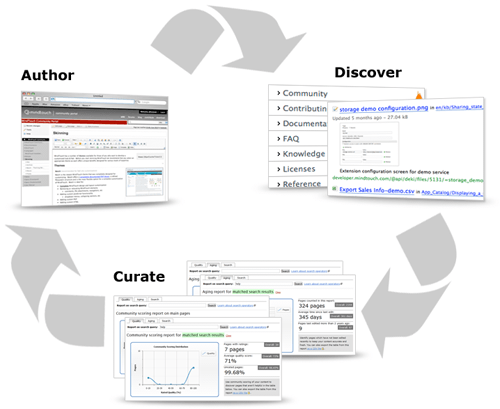
 First things first, we want you to learn the basics and then you can sign up for our weekly webinars where you'll learn more.
First things first, we want you to learn the basics and then you can sign up for our weekly webinars where you'll learn more.
Let's walk you through a brief overview of the functionality in MindTouch TCS. In this walk-through we'll be editing a sample user guide for a fictional product we're calling "The Acme Jetpack."
MindTouch TCS helps you create help content easily in two important ways. Here's how...
Included with MindTouch TCS is the Intelligent Documentation Framework (IDF), which provides both authoring and discovery tools - for now, we'll use the content templates to author content.
Let's start authoring by creating your first page in our sample Acme Jetpack user guide: a new page on "Acceleration" in the Propulsion topic.
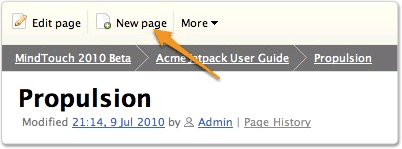
Click "New Page" once you're on the Propulsion page to launch the page gallery - MindTouch TCS provides a list of common documentation templates that aid in the Authoring process. Select "Feature Page" and then create your page.
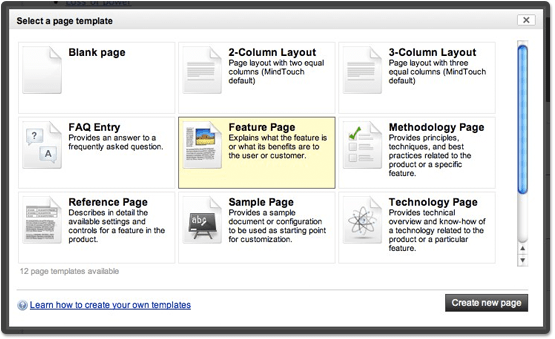
Notice the page automatically fills in a suggested structure for your content in the standards-compliant WYSIWYG editor. Add your content and hit "Save" - congratulations, you've created your first page!
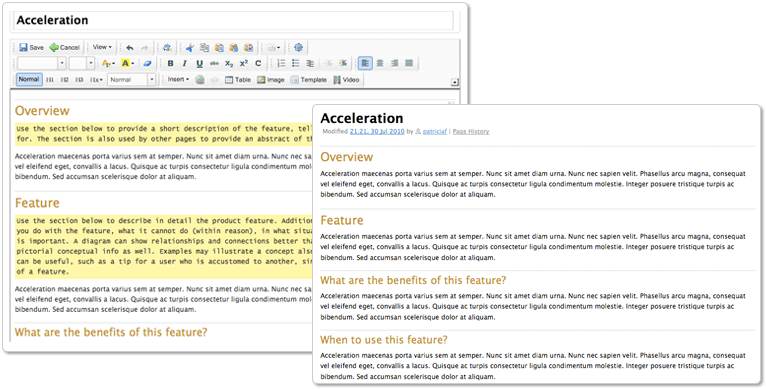
MindTouch TCS includes community scoring - rating pages from users helps both discovery and curation. Giving a positive (i.e. "thumbs up") review of a page boosts its ranking in search results for appropriate terms. For this example, you will rate a page negatively (i.e. "thumbs down") instead. Try giving your new page a negative rating - you'll be prompted to offer feedback on improving the page, which will be displayed as a comment for editors. This gives you insight into how your content is perceived by your community.
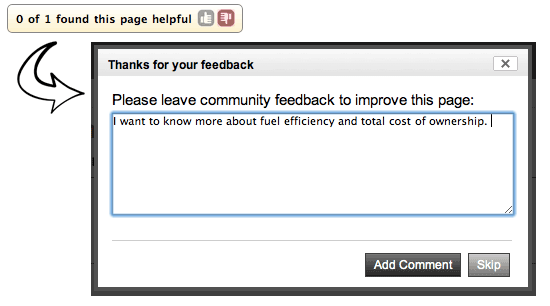
Next in MindTouch TCS is discovery. MindTouch TCS helps pages take on a life of their own. Here’s how...
When you create content using templates, MindTouch TCS’s Intelligent Document Framework (IDF) recognizes what content belongs where and dynamically organizes it for you in a way that allows your end users to easily find it.
By using templates you’re adhering to a methodology designed to make content easier for your community to find and understand.
Let's go back to the Acme Jetpack Guide - you'll see that the guide has automatically updated the table of contents with the new page you added - that's IDF at work! With IDF at hand, your authors only need to worry about writing and classifying content - MindTouch will self-organize the content to make it highly discoverable. You can also utilize page tags to have IDF organize tutorials, reference guides, and troubleshooting guides.
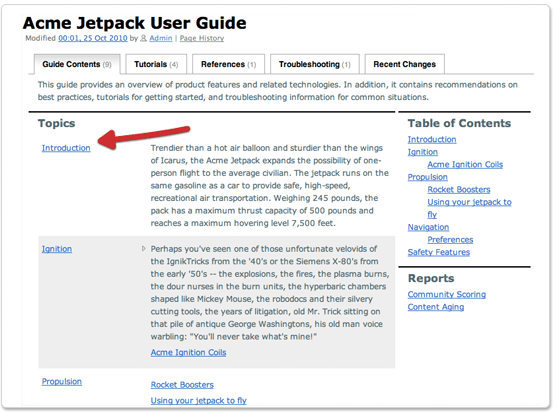
MindTouch TCS indexes content smartly. Here's how...
For users who are more comfortable with searching, MindTouch TCS offers adaptive search - a search algorithm which learns from your community's interaction with your content and builds collective intelligence. Community activities like rating pages and interacting with search results factor into search relevance. For example, with adaptive search, users can filter results to hierarchies and sort by modified date or title.
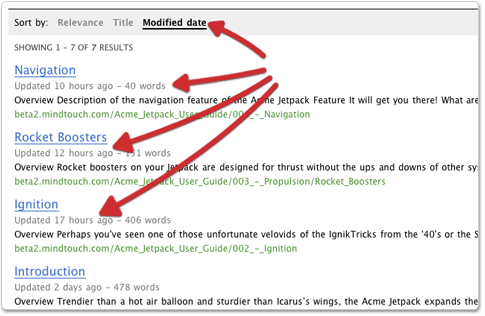
Adaptive search also feeds into curation - to see it in action, first search for "jetpack" and click through any of the pages. Next, we'll show you how you can learn from that interaction with curation analytics.
For content that needs improvement, we created curation analytics.
MindTouch TCS helps you curate content for the needs of your community. Here’s how…
This trial version of MindTouch TCS includes curation analytics. But there's a catch. Curation analytics solves the problem that you encounter when your content and community have grown too big to manage "manually." Therefore when you look at your analytics data today, it's going to be sparse. Look at it in a month, and you'll start seeing its benefits more clearly. Let's first work on building an audience and bucket loads of content.
What follows are some screenshots and descriptions of the features you'll find when you turn on curation analytics.
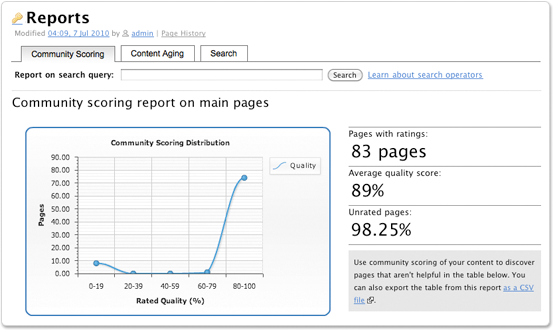
When you dive into the community scoring report - it identifies which content needs most attention in the eyes of the community. MindTouch TCS charting displays a visual distribution of your content as well as a table of metrics to measure the quality of your content. As the site continues to expand, low-scoring content will be pushed to the attention of your site curators. In addition, curation analytics allows you to filter your strategic content to focus on specific areas of interest. If you prefer to crunch your numbers in a separate program, note that all data from these reports can be downloaded as a CSV.
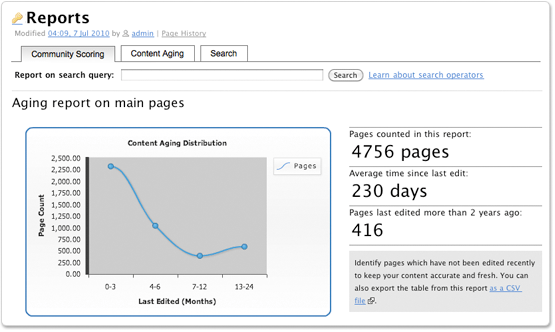
The content aging report analyzes your content by time of last edit. As your site ages, this report highlights pages that haven't been updated in a long time.
As with community scoring, curation analytics allows you to filter your help content to focus on specific areas of interest. Filter your reports by topic or hierarchy - the insights provided are endless.
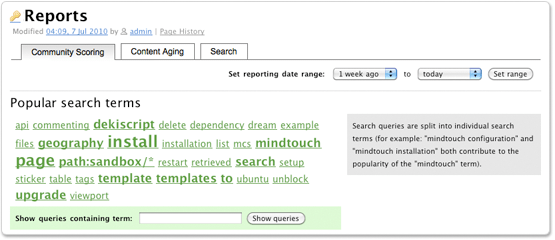
Search provides insight into what your users want. Tap into that insight to ensure you have coverage for the topics that your community needs help with. Execute reports on the most common search terms and queries with search analytics, and learn from the results what people are clicking through. As more searches are made, you'll see the search term cloud fill in. These are the terms that people are looking for - do you have help content to cover these needs? Search reporting helps product managers address unmet needs at the point of pain.
We hope this short walkthrough gave you insight into why MindTouch TCS is the right tool for your social help community. We're passionate about creating exceptional product help experiences, and this is only the beginning: you should sign-up for our weekly webinars to learn how to create better documentation and a thriving community.